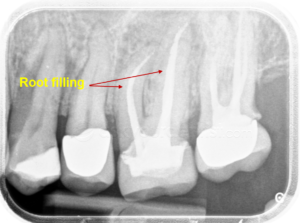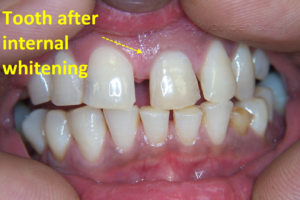
If a tooth is infected or badly damaged by trauma, a root canal treatment is necessary unless the patient decides to have the tooth out.
Root canal treatment is removing the tissue from the inside of the tooth and replacing it with a filling.
When do I need a root canal treatment?
If decay is left untreated, it reaches the pulp inside the tooth and damages the pulp tissue (that consists of nerves, blood vessels, lymphatic vessels and other tissues), causing an infection.

The infection can develop with or without pain. If not treated, an abscess can form around the root of the tooth in the jawbone causing pain and swelling.
The abscess can be treated temporarily with antibiotics. But to get rid of the abscess permanently and save the tooth, a root canal treatment is necessary.
A tooth does not have to be infected to have a root canal treatment.
For example, if a tooth is badly broken and not sufficient to put a crown on, a root filling is performed. A post or a screw is placed inside the tooth to form the foundation that is used to put the crown on. This extensive treatment is referred to as a post and crown.
Are root canal treatments always successful?
There is always a risk of the root canal treatment failing and the abscess returning. An abscess can return months or years after a root canal treatment is completed.
Some reasons for failure are:
Abscess
- Extremely resistant infectious bacteria.
- Complicated root canal system in the tooth.
- The dentist’s skills.
- The choice of tools and materials used to perform the root canal treatment.
Your dentist may decide to perform the root canal treatment or to refer you to a specialist, endodontist.
Do I need to have a crown after root canal treatment?
In order to get access to the nerve room inside the tooth during root canal treatment, your dentist has to remove a considerable amount of tooth substance. This can weaken the tooth and make it more vulnerable to pressure if the tooth is rebuilt with conventional filling materials. Therefore your dentist may recommend a crown to be put on top of the root-filled tooth after the root canal treatment has been completed to protect the tooth from cracking.
Why did my tooth discolour after root canal treatment?
Some root-filling materials can discolour teeth. This matters more when the treated teeth are in the front. This may happen within months or years after the root canal treatment. To get rid of the discolouration, the tooth is whitened from the inside.
In certain cases where the tooth is heavily discoloured, the internal whitening (internal bleaching of teeth) needs to be repeated. If the tooth does not respond to internal whitening, a crown may be the choice of treatment.
This patient had a root-filling done on his left central incisor. Few years later the tooth got discoloured. After performing internal whitening we obtained a satisfactory result that the patient was happy with.


